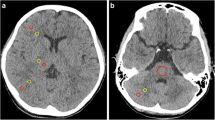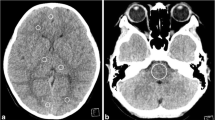Abstract
Background
Advanced virtual monochromatic reconstruction from dual-energy brain CT has not been evaluated in children.
Objective
To determine the most effective advanced virtual monochromatic imaging energy level for maximizing pediatric brain parenchymal image quality in dual-energy unenhanced brain CT and to compare this technique with conventional monochromatic reconstruction and polychromatic scanning.
Materials and methods
Using both conventional (Mono) and advanced monochromatic reconstruction (Mono+) techniques, we retrospectively reconstructed 13 virtual monochromatic imaging energy levels from 40 keV to 100 keV in 5-keV increments from dual-source, dual-energy unenhanced brain CT scans obtained in 23 children. We analyzed gray and white matter noise ratios, signal-to-noise ratios and contrast-to-noise ratio, and posterior fossa artifact. We chose the optimal mono-energetic levels and compared them with conventional CT.
Results
For Mono+maximum optima were observed at 60 keV, and minimum posterior fossa artifact at 70 keV. For Mono, optima were at 65–70 keV, with minimum posterior fossa artifact at 75 keV. Mono+ was superior to Mono and to polychromatic CT for image-quality measures. Subjective analysis rated Mono+superior to other image sets.
Conclusion
Optimal virtual monochromatic imaging using Mono+ algorithm demonstrated better image quality for gray–white matter differentiation and reduction of the artifact in the posterior fossa.





Similar content being viewed by others
References
Brooks RA (1977) A quantitative theory of the Hounsfield unit and its application to dual energy scanning. J Comput Assist Tomogr 1:487–493
Postma AA, Hofman PA, Stadler AA et al (2012) Dual-energy CT of the brain and intracranial vessels. AJR Am J Roentgenol 199:S26–S33
Alvarez RE, Macovski A (1976) Energy-selective reconstructions in X-ray computerized tomography. Phys Med Biol 21:733–744
Yeh BM, Shepherd JA, Wang ZJ et al (2009) Dual-energy and low-kVp CT in the abdomen. AJR Am J Roentgenol 193:47–54
Godoy MC, Naidich DP, Marchiori E et al (2009) Basic principles and postprocessing techniques of dual-energy CT: illustrated by selected congenital abnormalities of the thorax. J Thorac Imaging 24:152–159
Flohr TG, McCollough CH, Bruder H et al (2006) First performance evaluation of a dual-source CT (DSCT) system. Eur Radiol 16:256–268
Grant KL, Flohr TG, Krauss B et al (2014) Assessment of an advanced image-based technique to calculate virtual monoenergetic computed tomographic images from a dual-energy examination to improve contrast-to-noise ratio in examinations using iodinated contrast media. Investig Radiol 49:586–592
McCollough CH, Leng S, Yu L et al (2015) Dual- and multi-energy CT: principles, technical approaches, and clinical applications. Radiology 276:637–653
Graser A, Johnson TR, Bader M et al (2008) Dual energy CT characterization of urinary calculi: initial in vitro and clinical experience. Investig Radiol 43:112–119
Graser A, Johnson TR, Hecht EM et al (2009) Dual-energy CT in patients suspected of having renal masses: can virtual nonenhanced images replace true nonenhanced images? Radiology 252:433–440
Thieme SF, Becker CR, Hacker M et al (2008) Dual energy CT for the assessment of lung perfusion — correlation to scintigraphy. Eur J Radiol 68:369–374
Ben-David E, Cohen JE, Nahum Goldberg S et al (2014) Significance of enhanced cerebral gray-white matter contrast at 80 kVp compared to conventional 120 kVp CT scan in the evaluation of acute stroke. J Clin Neurosci 21:1591–1594
Brooks RA, Di Chiro G, Keller MR (1980) Explanation of cerebral white–gray contrast in computed tomography. J Comput Assist Tomogr 4:489–491
Schneider D, Apfaltrer P, Sudarski S et al (2014) Optimization of kiloelectron volt settings in cerebral and cervical dual-energy CT angiography determined with virtual monoenergetic imaging. Acad Radiol 21:431–436
Pomerantz SR, Kamalian S, Zhang D et al (2013) Virtual monochromatic reconstruction of dual-energy unenhanced head CT at 65–75 keV maximizes image quality compared with conventional polychromatic CT. Radiology 266:318–325
Vlahos I, Chung R, Nair A et al (2012) Dual-energy CT: vascular applications. AJR Am J Roentgenol 199:S87–S97
Yu L, Leng S, McCollough CH (2012) Dual-energy CT-based monochromatic imaging. AJR Am J Roentgenol 199:S9–S15
Schabel C, Bongers M, Sedlmair M et al (2014) Assessment of the hepatic veins in poor contrast conditions using dual energy CT: evaluation of a novel monoenergetic extrapolation software algorithm. Rofo 186:591–597
Albrecht MH, Scholtz JE, Husers K et al (2016) Advanced image-based virtual monoenergetic dual-energy CT angiography of the abdomen: optimization of kiloelectron volt settings to improve image contrast. Eur Radiol 26:1863–1870
Park JE, Choi YH, Cheon JE et al (2017) Image quality and radiation dose of brain computed tomography in children: effects of decreasing tube voltage from 120 kVp to 80 kVp. Pediatr Radiol. doi:10.1007/s00247-017-3799-8
Rozeik C, Kotterer O, Preiss J et al (1991) Cranial CT artifacts and gantry angulation. J Comput Assist Tomogr 15:381–386
Cicchetti D (1994) Guidelines, criteria, and rules of thumb for evaluating normed and standardized assessment instruments in psychology. Psychol Assess 6:284–290
Lin XZ, Miao F, Li JY et al (2011) High-definition CT gemstone spectral imaging of the brain: initial results of selecting optimal monochromatic image for beam-hardening artifacts and image noise reduction. J Comput Assist Tomogr 35:294–297
Meier A, Wurnig M, Desbiolles L et al (2015) Advanced virtual monoenergetic images: improving the contrast of dual-energy CT pulmonary angiography. Clin Radiol 70:1244–1251
Marin D, Nelson RC, Samei E et al (2009) Hypervascular liver tumors: low tube voltage, high tube current multidetector CT during late hepatic arterial phase for detection — initial clinical experience. Radiology 251:771–779
Tawfik AM, Kerl JM, Bauer RW et al (2012) Dual-energy CT of head and neck cancer: average weighting of low- and high-voltage acquisitions to improve lesion delineation and image quality-initial clinical experience. Investig Radiol 47:306–311
Ho LM, Yoshizumi TT, Hurwitz LM et al (2009) Dual energy versus single energy MDCT: measurement of radiation dose using adult abdominal imaging protocols. Acad Radiol 16:1400–1407
Kamiya K, Kunimatsu A, Mori H et al (2013) Preliminary report on virtual monochromatic spectral imaging with fast kVp switching dual energy head CT: comparable image quality to that of 120-kVp CT without increasing the radiation dose. Jpn J Radiol 31:293–298
Henzler T, Fink C, Schoenberg SO et al (2012) Dual-energy CT: radiation dose aspects. AJR Am J Roentgenol 199:S16–S25
Tawfik AM, Kerl JM, Razek AA et al (2011) Image quality and radiation dose of dual-energy CT of the head and neck compared with a standard 120-kVp acquisition. AJNR Am J Neuroradiol 32:1994–1999
Hwang WD, Mossa-Basha M, Andre JB et al (2016) Qualitative comparison of noncontrast head dual-energy computed tomography using rapid voltage switching technique and conventional computed tomography. J Comput Assist Tomogr 40:320–325
American College of Radiology (2014) ACR practice guideline for diagnostic reference levels in medical x-ray imaging. American College of Radiology, Reston
Author information
Authors and Affiliations
Corresponding author
Ethics declarations
Conflicts of interest
This research was supported by Research Program 2016 funded by Seoul National University College of Medicine Research Foundation (800–20,160,070). Authors Seong Young Pak and Bernhard Krauss are employees of Siemens Healthineers. However, control of all data and information submitted for publication was given to the authors who were not affiliated with Siemens Healthineers. The remaining authors have nothing to disclose.
Rights and permissions
About this article
Cite this article
Park, J., Choi, Y.H., Cheon, JE. et al. Advanced virtual monochromatic reconstruction of dual-energy unenhanced brain computed tomography in children: comparison of image quality against standard mono-energetic images and conventional polychromatic computed tomography. Pediatr Radiol 47, 1648–1658 (2017). https://doi.org/10.1007/s00247-017-3908-8
Received:
Revised:
Accepted:
Published:
Issue Date:
DOI: https://doi.org/10.1007/s00247-017-3908-8




